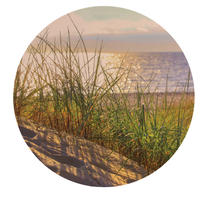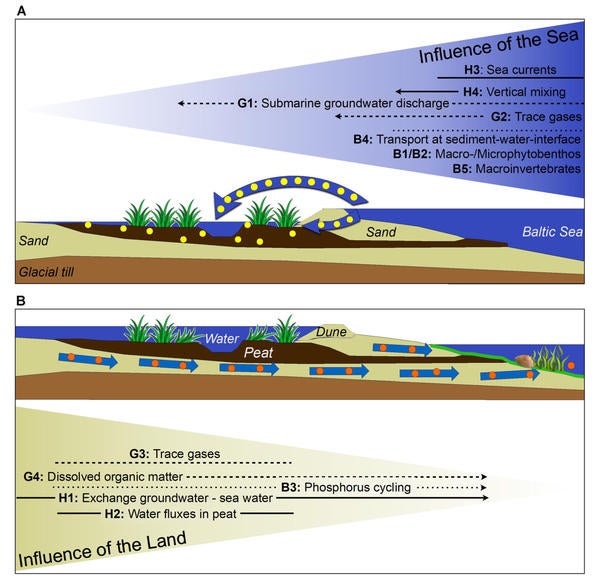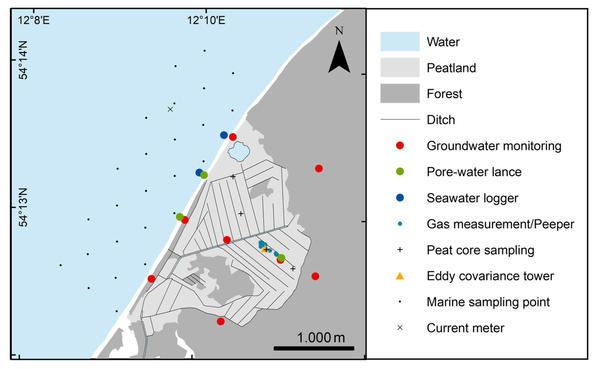 Coastal zones are ecoclines that connect terrestrial and marine ecosystems forming a unique environment that is under increasing anthropogenic pressure resulting in rising sea levels, sinking coasts, and changing precipitation patterns. Long-term changes in sea level, as well as periodic (tides) or episodic (storm surges) events, can affect large areas on both sides of the shoreline.
Coastal zones are ecoclines that connect terrestrial and marine ecosystems forming a unique environment that is under increasing anthropogenic pressure resulting in rising sea levels, sinking coasts, and changing precipitation patterns. Long-term changes in sea level, as well as periodic (tides) or episodic (storm surges) events, can affect large areas on both sides of the shoreline.
The coastline itself is rarely considered as an interface for the exchange of energy, water, and substances, yet this interface is very important as it operates continuously and may have far-reaching effects on hydro-physical, chemical and biological processes on both sides of the coast. Understanding the causes and impacts of change, potential tipping points and coasts in transition is critical for our ability to sustainably balance natural conservation and human use of the coasts.
The Baltic TRANSCOAST research program aims to enhance the fundamental understanding of the interconnected processes along the coastal ecocline by using a southern Baltic site, the Hütelmoor, as a model system. This paper outlines the hypotheses and research questions, and the interdisciplinary approach and first results of the research program.
Methodology
A systematic interdisciplinary research approach that considers the coast as a continuum of physical and biogeochemical processes that influence marine and terrestrial biota, and that are impacted by this biota, is used (Figure 1). A low-lying fen peat site, that includes the off shore shallow sea area, has been chosen to characterize and quantify various processes across the land-sea interface.

FIGURE 1: Baltic TRANCOAST research approach showing the spatial coverage of different research themes (H-Hydro-physical, G-Biogeochemical, B-Biological) and the prevailing water and substance exchange pathways (A) during storm surge events, and (B) when groundwater and surface water levels are high on the land side. The arrows indicate the spatial processes across the coastal ecocline.
The research addresses the following main hypotheses in three theme areas:
(i) There is an exchange of water and matter between land and sea in both directions, on varying spatial and temporal scales at shallow coasts.
(ii) Both on land and in the sea, exchange processes influence the biogeochemical processes either directly or by impacting the biota.
(iii) The volume flux of water originating from the terrestrial side in the shallow sea may be a low, but possibly constant, source of nutrients and complex organic molecules.
(iv) The impact of sea-borne water on the terrestrial side is expected to be episodic, but with long-lasting consequences for biogeochemical cycling.
The hydro-physics theme area comprises oceanographic and groundwater modelling, including coupling near the shoreline. Sea level dynamics are modelled by interactively coupling a General Estuarine Transport Model (GETM) with a wind-wave model, while near-shore hydrodynamics are determined by wind-driven transport and the plume from an adjacent river. Groundwater dynamics are represented using the United States Geological Survey’s MODFLOW model and measured groundwater levels. Hydraulic properties of the various substrates were either tested in situ or measured in the lab. Hydrodynamic measurements and modelling are supported by isotope analyses.
The biogeochemistry theme investigates pathways of carbon, nitrogen, phosphorus, and sulfate across the land-ocean interface by analyzing pore waters and sedimentary substrates to investigate vertical profiles of concentrations and stable isotope compositions of various dissolved, solid, and gaseous compounds, as well as to characterize the underlying biogeochemical processes and the impact of microbial activities.
The biology theme assesses the tolerance thresholds beyond which the physiological impacts of salinity translate into reduced activity, growth and/or survival, thereby affecting the key ecological functions of bioturbation and bioirrigation. The physiological data are upscaled to community-level effects by developing models of bioturbators’ contributions to oxygen, nutrient, water fluxes, and sediment reworking.
The study site has been instrumented both on land and in the sea (Figure 2). On the land side, chamber measurements, used for regular greenhouse gas, pore and surface water sampling, are arranged in clusters with replicates in different vegetation types. Groundwater monitoring wells were installed in transects across the peatland, with various measurements collected at upper sand, peat, and lower sand depths. Site geology was characterized through 17 drillings and numerous peat cores.

FIGURE 2: Study site instrumentation
On the marine side, two stationary pore water lances were installed in the sediments in front of the study site allowing for water sampling at discrete depth intervals, as well as data loggers for salinity, irradiance, and temperature in the surface water. Further offshore, water and sediment sampling took place via small boats. Macrophytobenthos assessment was completed by diving along transects.
Outcomes
Early results of the Baltic TRANCOAST research program show that the land and sea sections of the coastal ecocline mutually influence and impact each other. Importantly, the exchange is operational despite low gradients in a non-tidal system. Although a dune functioning as a dyke between the sea and land exists, the salinity distribution in the peatland reveals the legacy of flooding events. This occasional flooding has altered the hydraulic and biogeochemical properties of the peat soils and is expected to become more frequent in the future with a shift in precipitation patterns.
Water flux-based exchange processes within the peat body operate at small rates, while deeper groundwater fluxes and at its border might be more relevant. Recently introduced peatland rewetting measures may have enhanced submarine groundwater discharge, as indicated by distinct patterns of salinity in the nearshore sediments, making the coastal waters in front of the study site a mixing zone of fresh and brackish water. As the land area along the study site is discharging directly into the sea, we conclude that biogeochemical and resulting biological processes in the shallow sea might be regulated to a great extent by nutrient and complex organic matter fluxes originating from peatland. High nutrient loadings, dissolved inorganic carbon, and dissolved organic matter originating from the degraded peat may affect micro- and macro-phytobenthos, with the impact propagating to higher trophic levels.
Generally, elevated sulfate concentrations are assumed to influence greenhouse gas emissions, mainly by inhibiting methane production, yet our investigations indicate complex interactions between the different biogeochemical element cycles such as carbon and sulfur caused by connected hydrological pathways.
Conclusions
In conclusion, coastal ecocline interactions are far-reaching, occurring on either side of the land-sea interface, and can only be understood when both long-term and event-based patterns and different spatial scales are considered. A systems approach, in which the coast is considered as a continuum that extends from land to sea, seems to be promising to support understanding of the ecosystem functioning of shelf seas and low lying coastal wetlands. We demonstrate that interdisciplinary collaboration among both terrestrial and marine hydrophysicists, biogeochemists and biologists gives new insight into interconnected operating processes.
In the future, in situ measurements of transformations in carbon-sulfur cycles, and the dating of different water sources will allow for a better mechanistic understanding of actual processes and the importance of water as a driver for element transport. A hydrodynamic model, based on physical properties of land and sea environments, will allow for the prediction of larger-scale water fluxes. These fluxes can then be used to calculate nutrient and other relevant compound balances, while bioenergetically-based ecological models will be used to assess the effects of common environmental stressors on marine biota.
Jurasinski, G., Janssen, M., Voss, M., B.ttcher, M.E., Brede, M., Burchard, H., Forster, S., Gosch, L., Gr.we, U., Gründling- Pfaff, S., Haider, F., Ibenthal, M., Karow, N., Karsten, U., Kreuzburg, M., Lange, X., Leinweber, P., Massmann, G., Ptak, T., Rezanezhad, F., Rehder, G., Romoth, K., Schade, H., Schubert, H., Schulz-Vogt, H.N., Sokolova, I.M., Strehse, R., Unger, V., Westphal, J., & Lennartz, B. (2018). Understanding the coastal ecocline: Assessing sea–land interactions at non-tidal, low-lying coasts through interdisciplinary research. Frontiers in Marine Science, 5(342). doi:10.3389/fmars.2018.00342.
Contact: Fereidoun Rezanezhad, Department of Earth and Environmental Sciences
Mercator Fellow, Baltic TRANSCOAST Research Training Group, Rostock University, Germany
For more information about WaterResearch, contact Julie Grant.







